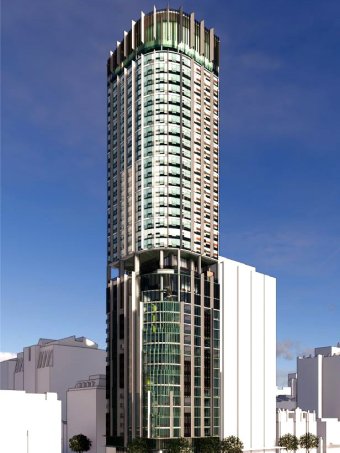More than half of all buildings expected to be standing in Australia in 2050 will be built after the next update of the National Construction Code (NCC) in 2019. It’s more important than ever to get those buildings right, experts say, particularly if we hope to meet our 2030 emissions reduction targets outlined in the Paris Agreement.
According to the Low Carbon, High Performance report from the Australian Sustainable Built Environment Council (ASBEC), “actions to reduce emmissions from the building sector (including new and existing buildings), could deliver 28 per cent of Australia’s 2030 emissions reduction target”.
Click here to watch weekly episodes of our Housing Development Programme on AIT
But changes to the NCC are not just intended to satisfy the details of the Paris Agreement. They also have to do with the fact that we simply can’t afford not to change the way buildings are made, said ASBEC Executive Director Suzanne Toumbourou.
“The country has recognised that there is a real issue with spiralling energy costs,” Toumbourou said.
“We don’t have to invent a new material or process. The technology exists right now. It’s just a matter of facilitating and enabling those processes, practices and technologies to be rolled out through the industry.”
ASBEC, along with Climate Works Australia and through the July 2018 report called Built to Perform, is recommending that longer term targets around energy performance be written into the NCC. This will offer the building industry a visible pathway and encourage businesses to innovate.
“We’ve seen a parallel issue with the energy market, where a lack of policy direction has reduced investor confidence and increased energy prices,” she said.
“There is an opportunity through the NCC to do it much better by setting targets to 2030.”
 The challenge
The challenge
The Building Ministers Forum oversees policy and regulatory issues affecting Australia’s building and construction industries. The Forum decreed that changes to the NCC must be based on an economic analysis.
This could be a problem in a small market such as Australia, said Jonathan Barnett, Managing Director of Basic Expert Pty Ltd. Barnett is Chair of the Engineers Australia Society of Fire Safety, a key adviser for advocacy to government on improving regulation and compliance with construction rules.
Engineers Australia recently submitted its National Construction Code 2019 review, which contains significant detail around flood and fire safety engineering.
“We’re a small country, so we’re looking at small data statistics, which is a different world of statistics to those in a large country,” Barnett told create.
“If you only look at Australia, you would say, ‘We’ve only had one cladding fire. Nobody died. What’s the big deal?’ But there was a big fire in China in 2000 where people died. There was a fire in Azerbaijan where people died, and then in England … The entire world should be part of our data set.”
Resistance to change most often comes as a result of cost, said Adrian Piani, Canberra Area Manager at AECOM and Engineers Australia’s Chair of the Environmental College.
“There’s always a dilemma between upfront capital costs versus whole-of-life costs,” said Piani, who is also Engineers Australia’s ASBEC representative.
“People will argue that you shouldn’t make a house more expensive.
“But engineers know that technology changes, knowledge changes and the needs of society change. There is a global need to reduce carbon emissions, but an equally important driver is the economic one. We’re talking about reducing whole-of-life cost. If we build infrastructure that lasts 50 to 100 years and make good decisions at the design phase, it creates a solution that will be cheaper over its lifespan.”
Often, good design creates better outcomes with a lower upfront cost, so sometimes the cost factor will be negated from the very beginning, Piani said.
“So our role at Engineers Australia is to support the analysis,” he said.
“Engineers Australia was a contributor to the funding for the Built to Perform project because we’re a supporter of good design and good engineering. Engineers Australia has a sustainability policy and a climate change policy. We recognise the need for sustainable outcomes across all of our sectors”.
Registering engineers
Piani said that while the NCC outlines the regulatory requirements, it is up to engineers to implement many of those requirements. It is expected that a fully competent, professional engineer will make good decisions during the design.
“There is also an expectation that the people doing the work will act ethically and with the required level of skill,” Piani said.
“How do you know that’s happening? At the moment, there is no professional accreditation required, but you’d be more confident if you knew a Chartered engineer, who had signed a code of ethics, was working on your project. It creates a connection of trust between the construction team ,the developers and the community”
Fanning the flames
There is one other reason for constant change and improvement: without it, things tend to go backwards.
In 1666 the Great Fire of London devastated the city during its four days aflame. Around 13,200 houses and 87 parish churches were destroyed. This fire, believed to have begun in a bakery, was fed by combustible cladding, as were the flames that consumed Rome 1600 years earlier.
In between these two events, several other cities burned. Building methods changed as a result, but lessons were soon forgotten, and history would repeat. Much of the city of Pittsburgh would burn to ash in 1845, as would Chicago in 1871 and Toronto in 1904.
Then in London on 14 June 2017, the 24-storey Grenfell Tower burned for 60 hours, killing 72 residents — again as a result of flammable cladding.
“When we develop new building techniques, new materials and new ways of putting things together, there’s an expectation that we are at least maintaining the same level of risk we’ve had in the past,” Barnett said.
“But unfortunately, because fire is such a low-frequency event, we tend to relax our regulations and enforcement over time. This increases the level of risk, and we don’t realise we’ve done that until there’s a crisis.”
 Rising water
Rising water
Toby McGrath, senior associate with Water Solutions and member of Engineers Australia’s National Committee on Water Engineering, said similar thought and effort must go into the code around flood safety. Even though floods are rare events, recent experiences in flooding across Australia demonstrate that it is essential that all buildings exposed to flooding are designed to resist its effects.
“The NCC contains structural design guidelines for safety in infrequent disasters, including earthquakes and high winds, but similar design guidance has not been provided for rare floods.”
Engineers Australia has provided a range of recommendations for improvement of the NCC to the Australian Building Codes Board (ABCB), related to flood safety and other matters. in its National Construction Code 2019 review submission.



 The challenge
The challenge Rising water
Rising water
